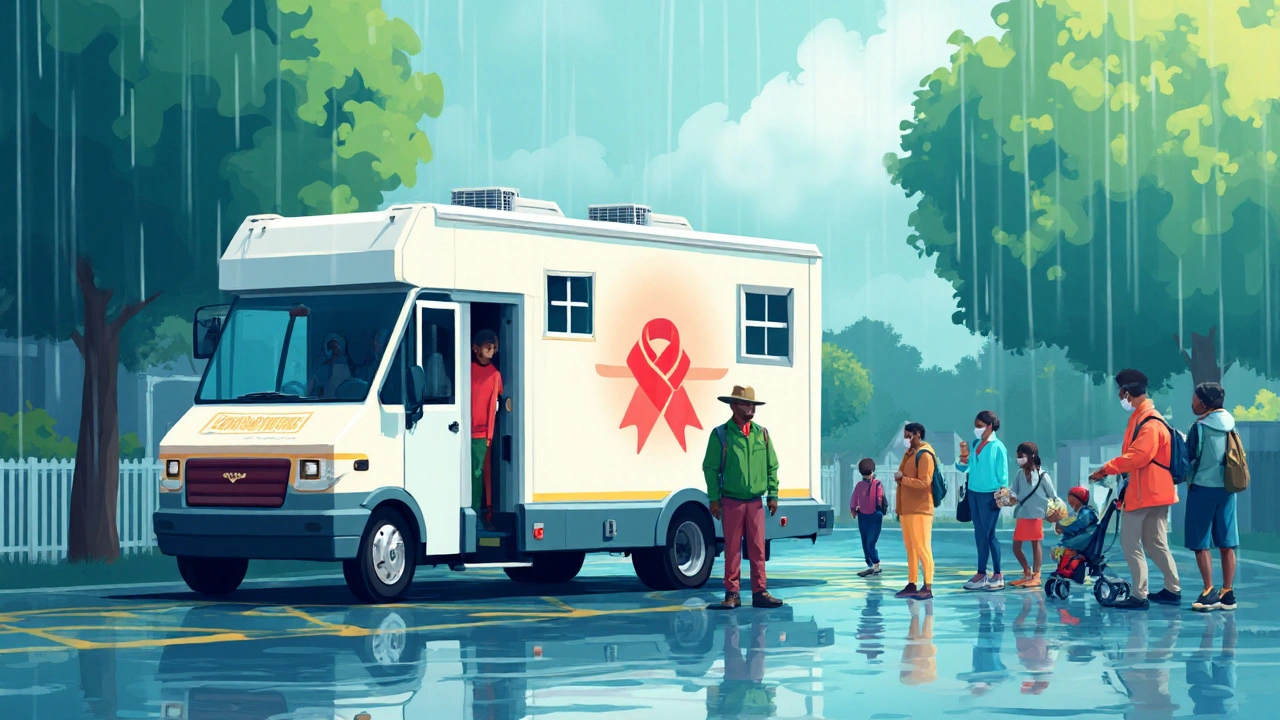Key Takeaways
- Rising temperatures and erratic weather patterns can broaden the geographic reach of syphilis.
- Climate‑driven migration and urban crowding reshape sexual networks, increasing exposure risk.
- Health systems must adapt surveillance, testing, and education to stay ahead of climate‑linked spikes.
- Co‑factors like HIV, antimicrobial resistance, and socioeconomic vulnerability intensify the threat.
- Targeted mitigation-early‑warning systems, mobile clinics, and climate‑smart policies-can curb future outbreaks.
Syphilis is a sexually transmitted infection (STI) caused by the spirochete Treponema pallidum. The disease follows three stages-primary, secondary, and tertiary-each with distinct symptoms, and WHO reports roughly 6million new cases worldwide each year.
Climate change is the long‑term shift in global temperature, precipitation, and extreme‑event frequency driven primarily by human‑generated greenhouse‑gas emissions.
How a Warming Planet Alters the Environment for Syphilis
When average temperatures climb 1.5°C above pre‑industrial levels-a target many nations are now chasing-human behavior and pathogen biology adjust in tandem. Warmer climates accelerate the replication of many microbes; for syphilis, the effect is indirect but still meaningful.
Temperature rise contributes to longer outdoor social seasons, extending the window when people meet in parks, beaches, or outdoor festivals-settings that often precede intimate encounters.
Changes in precipitation patterns also matter. Drought‑prone regions experience water‑stress‑driven migration, while flood‑affected zones see temporary shelters packed with displaced families. Both scenarios generate dense, transient populations where health‑promotion messages struggle to reach.
Human Mobility and Sexual Networks in a Changing Climate
One of the strongest links between climate and syphilis is migration. The United Nations estimates that by 2030, climate‑related migration could affect 200million people. Newcomers often settle in urban peripheries with limited health services, creating pockets of vulnerability. These “hotspots” can become flashpoints for STI spread.
Urbanization itself is a climate‑driven phenomenon. As sea levels rise, low‑lying coastal cities-think Auckland or Miami-push residents inland, where rapid housing growth outpaces infrastructure. Overcrowded neighborhoods foster dense sexual networks, and anonymity can rise, making partner tracing harder.
Additionally, climate stress can shift social norms. In regions hit by repeated hurricanes, economic strain may push individuals toward transactional sex as a coping strategy, directly raising syphilis exposure.
Biological and Clinical Factors Tied to the Environment
While syphilis is not vector‑borne, the bacterium Treponema pallidum shows modest temperature sensitivity. Laboratory studies reveal that at 37°C the organism multiplies fastest; higher ambient temperatures can shorten the incubation period once transmitted, potentially leading to earlier symptom onset.
Climate change also amplifies co‑infection risks. HIV co‑infection rates tend to rise in the same communities where syphilis spikes, because both share transmission routes. Immunosuppression from HIV can accelerate syphilis progression, complicating diagnosis.
A worrying downstream effect is antimicrobial resistance. While penicillin remains highly effective, rising antibiotic misuse-often seen in emergency shelters where over‑the‑counter drugs are readily available-creates selective pressure that could eventually erode treatment options.

Public‑Health Surveillance in a Climate‑Active Era
Modern surveillance must integrate climate data with traditional epidemiology. Public health surveillance systems now pull temperature, rainfall, and migration dashboards to predict where syphilis clusters may emerge.
For example, a pilot program in New Zealand’s South Island linked weekly syphilis case counts to regional temperature anomalies. When average highs exceeded 22°C for three consecutive weeks, local clinics saw a 12% rise in new diagnoses within the following month.
These early‑warning models enable targeted outreach: mobile testing units, rapid‑response education campaigns, and a temporary boost in condom distribution.
Comparison of Transmission Drivers: Pre‑ vs. Post‑Climate Change
| Driver | Pre‑climate‑change Context | Post‑climate‑change Context |
|---|---|---|
| Temperature | Seasonal peaks, limited outdoor contact | Extended warm periods, longer exposure windows |
| Population movement | Stable internal migration rates | Climate‑driven displacement, new urban settlements |
| Healthcare access | Established clinics in dense towns | Strained services in rapidly growing peripheries |
| Co‑infection risk | Baseline HIV prevalence | Higher HIV rates in displaced populations |
| Antibiotic misuse | Regulated prescription pathways | Increased over‑the‑counter use in emergencies |
Mitigation and Adaptation Strategies
Addressing the climate‑syphilis nexus requires a blend of short‑term actions and long‑term policy.
- Climate‑smart surveillance: Integrate weather APIs into disease‑reporting platforms to flag potential spikes.
- Mobile testing units: Deploy rapid‑test kits to temporary shelters and flood‑relief camps.
- Targeted education: Tailor messaging for migrant communities, using multilingual flyers and community leaders.
- Strengthen antimicrobial stewardship: Train clinicians in displaced‑area clinics to prescribe responsibly.
- Infrastructure planning: Ensure new urban districts include accessible sexual‑health clinics from the start.
These steps echo the broader push for climate‑resilient health systems, which aim to keep essential services functional during extreme events.
Related Concepts and Further Reading
Understanding syphilis in a warming world also touches on other topics:
- vector‑borne diseases like dengue, whose incidence is directly driven by mosquito habitats.
- water‑borne infections that surge after floods.
- The broader field of climate‑sensitive health outcomes, encompassing heat‑related mortality and respiratory illnesses.
Readers interested in the mechanics of disease‑environment interaction may next explore "Climate Change and HIV Transmission" or "Heatwaves and Respiratory Health".

Frequently Asked Questions
Will warmer temperatures directly increase syphilis cases?
Temperature alone doesn’t make the bacterium spread faster, but longer warm periods encourage social activities where transmission can occur. Combined with migration and strained health services, the net effect is a measurable rise in cases.
How does climate‑related migration affect syphilis risk?
Migrants often settle in dense, underserved neighborhoods where health outreach is limited. Overcrowding and disrupted social networks can lead to higher numbers of new partners, raising the probability of STI transmission, including syphilis.
Are there any climate‑specific diagnostic tools for syphilis?
Not yet. Current rapid tests work regardless of climate. However, mobile point‑of‑care kits are being piloted in disaster‑relief zones to bring diagnostics to people who would otherwise lack access.
Can climate change affect the effectiveness of penicillin?
Penicillin remains potent against Treponema pallidum. The challenge is not the drug itself but ensuring timely delivery. Climate‑disrupted supply chains can delay treatment, indirectly worsening outcomes.
What role does antimicrobial resistance play in syphilis trends?
Although resistance to penicillin is rare, misuse of alternative antibiotics in emergency settings can select for resistant strains of other bacteria, complicating co‑treatment of concurrent infections and stretching public‑health resources.

